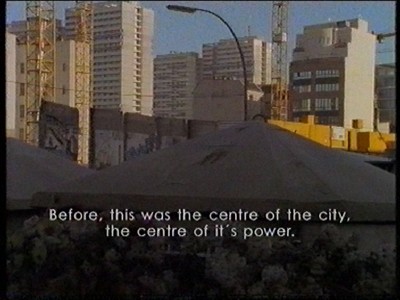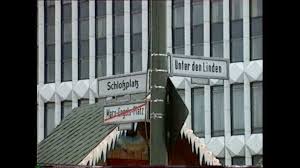At university we watched Hito Steyerl’s documentary “Die Leere Mitte” in a seminar, for the work on an article I wanted to quote now some passages from the film and watched it again. 2010 it was already a document of contemporary history, to see it eight years later was just as affective as the first time, that’s why I wanted to write a review about it this time. So then – here we go!
Hito Steyerl is filmmaker, artist and theorist. She deals with questions of postcolonial criticism, representation and feminist perspectives. Usually in the form of essayistic documentaries, media-installations, texts and other artistic forms. The art magazine “ArtReview” lists Steyerl 2017 on the annual “Power100” list as one of the most influential female artist in the international art scene. This was not the case in 1998 when she made this documentary, but the documentary is surley a reason why she made it that far.
 It is an important analytic contribution about contemporary Berlin and the question of how cities exclude and whom – is Steyerl’s “Die Leere Mitte”, whose starting point is the construction site at Potsdamer Platz at the end of the 1990s, which was the biggist construction side of Europe at that time, where the death strip used to be located. A central theme of the documentation is that where borders are torn down, new ones immediately emerge. The focus is also on the connections between political power and architecture, as well as issues of exclusion. Using the history of the construction site as a narrative, where until the end of the Second World War the centre of ‘German’ power was located and afterwards the nothingness of the inner-German border as a manifestation of the Cold War, the documentary illustrates how new manifestations of power arise. And thus also new forms of exclusion, which seem to repeat history in a kind of variation. The film unmasks the mythology that the fall of the Berlin Wall brought “freedom” for the citizens of Berlin or Germany.
It is an important analytic contribution about contemporary Berlin and the question of how cities exclude and whom – is Steyerl’s “Die Leere Mitte”, whose starting point is the construction site at Potsdamer Platz at the end of the 1990s, which was the biggist construction side of Europe at that time, where the death strip used to be located. A central theme of the documentation is that where borders are torn down, new ones immediately emerge. The focus is also on the connections between political power and architecture, as well as issues of exclusion. Using the history of the construction site as a narrative, where until the end of the Second World War the centre of ‘German’ power was located and afterwards the nothingness of the inner-German border as a manifestation of the Cold War, the documentary illustrates how new manifestations of power arise. And thus also new forms of exclusion, which seem to repeat history in a kind of variation. The film unmasks the mythology that the fall of the Berlin Wall brought “freedom” for the citizens of Berlin or Germany.
At the Potsdamer Platz construction site, Dong Yang, a Berlin student of Asian origin who had been beaten by rights, is interviewed by the filmmaker. He says: “After the fall of the Berlin Wall the Germans were very excited, I have the feeling that they have forgotten what they are. It would be better for the foreigners if the wall would still be here”.
The documentation is blending historical retrospects with present events related to the construction site.
 A narrator reports that after the fall of the wall, the empty strip between the walls was sold to investors. After two months life returns to the empty center. Protesters came with tents occupying the death strip, because – as one of them explains “Daimler-Benz got the site for nothing and we want to protest against this situation that only the richest of the rich get again these historical places in the city’s center. There won’t be any more room for people with different attitudes and life-styles, it’s all about money”.
A narrator reports that after the fall of the wall, the empty strip between the walls was sold to investors. After two months life returns to the empty center. Protesters came with tents occupying the death strip, because – as one of them explains “Daimler-Benz got the site for nothing and we want to protest against this situation that only the richest of the rich get again these historical places in the city’s center. There won’t be any more room for people with different attitudes and life-styles, it’s all about money”.
Towards the end the occupiers of the Death Strip are asked what they want to achieve? They answer that they want to have a say in what is being built here in the center of their city. A few scenes later a young Chinese woman says that the wall has now gone, but that the purpose of this wall was to regulate territorial relations between people and in that way it is still existing. The voiceover is reporting that while Germany is reuniting and the former nomansland is being opened for market opportunities, that the borders elsewhere are consolidated: several hundred people die on the borders of Europe. They drown, suffocate, freeze to death or die of thirst. And also within Germany national liberated zones are being put up. Historically the construction of borders can be interpreted as a tradition in this area around Potsdamer Platz. Fortunately we a left with a quotation by Kracauer and a few humorous moments in the credits, so that one is not left completely disillusioned.
Strongly recommend!







